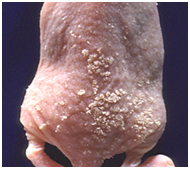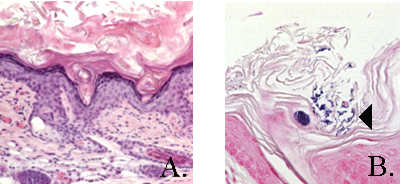Etiology: Corynebacterium bovis is a Gram-positive rod which has been identified as the cause of a bacterial skin disease of nude mice referred to as “scaly skin disease”. The condition typically affects hairless mice such as adult homozygous nude as well as SKH-1 mice.
Incidence: The incidence of infection with Corynebacterium bovis is low.
Transmission: The bacterium is carried on the skin and in the oral cavity of mice, and is transmitted by direct contact and by fomite transmission (handling, flake contact, etc.).

Clinical signs: C. bovis is usually manifested as a hyperkeratosis with yellow-white flakes adherent to thickened skin. Affected mice may lose weight and are often removed from study because of reports of poor growth of transplanted tumors or hindrance of immunologic studies. Mortality is low and the hyperkeratosis is transient but may recur. Mice may be persistently colonized, even without displaying clinical signs. C. bovis has also been cultured from skin of asymptomatic hirsute immunocompetent mice.
Pathology: Histologic examination of the skin reveals acanthosis and orthokeratotic hyperkeratosis with a mononuclear cell dermal infiltrate (A.). Short, Gram-positive rods arranged in clusters and pallisades can be recognized in the stratum corneum on Gram-stained skin sections (arrowhead, B.).
Diagnosis: The bacterium can be detected in skin and environmental samples by a C. bovis-specific PCR test. The bacterium can also be cultured by inoculating blood agar with skin or buccal swabs.
